Elsevier Encyclopedia of Geology - vol I A-E
Подождите немного. Документ загружается.

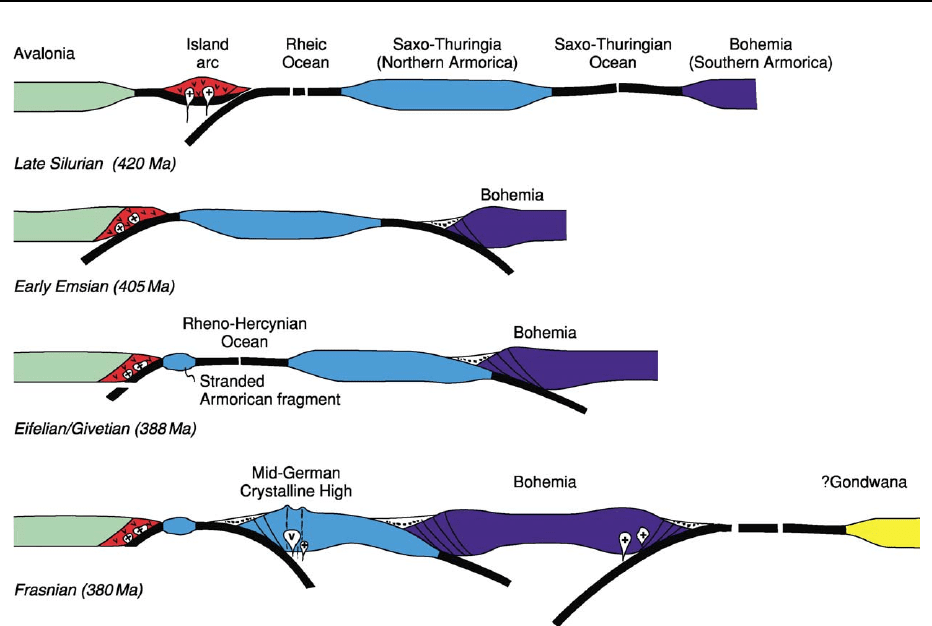
The present-day Variscan Belt of central Europe
is not a linear feature. In Early Carboniferous times,
the paralinear or linear subduction and collision
zones were transported north-westwards, and drag
along the south-western margin of Baltica caused it
to rotate clockwise through approximately 90
(Figures 1 and 5). In about the latest Early Carbon-
iferous, the south-eastern flank of this ‘Bohemian
Arc’ was truncated by a huge transpressional fault
zone (the Moldanubian ‘Thrust’), which carried the
south-eastern blocks south-westwards, possibly for a
distance of about 1500 km.
Geological Record: Western Europe
An even more prominent arc structure is observed in
the western part of the Variscan belt: if Iberia is
rotated into its pre-Mesozoic position by closing the
bay of Biscay, Variscan structures define a tight arc
with a curvature of 180
in its internal part (the
‘Ibero-Armorican’ arc) (Figure 1).
The terranes of north-west Iberia are clearly
linked with those of Brittany and the Massif Central
in France and can be traced further eastwards into
the Bohemian Massif, thus forming parts of the
Armorican Terrane Assemblage. As in central Europe
(see above), cross-sections through the two arms of
the Ibero-Armorican virgation show a fan-like orogen
with opposite vergences (verging towards the north-
east and south-west in Iberia, and towards the south
and north in France), i.e. convergent on its concave
side and divergent on its convex side.
Two main sutures are visible in the internal meta-
morphic parts of the belt, and are the roots of nappes
with opposing vergences (Figures 6 and 7). The
Beja suture resulted from the closure of an oceanic
realm between Avalonia (the south Portuguese fore-
land) and Armorica. There are no pre-Carboniferous
rocks exposed in south Portugal, thus it remains un-
certain whether this oceanic realm was the early
Palaeozoic Rheic Ocean or a younger Devonian fea-
ture (as in south-west England and Germany). In any
case, the Beja suture can be correlated with the
Rheno-Hercynian ophiolites of the Lizard complex
in south-west England and the Gießen-Harz Nappe
in Germany. The second suture resulted from the
closure of the Galice-Brittany ocean and can be traced
from the French Massif Central, through the southern
Vosges and Black Forest, into the Moldanubian belt
of the Bohemian Massif (Figure 1). In contrast to
Figure 4 Plate kinematic evolution of central Europe, after Franke W (2000) The mid-European segment of the Variscides:
tectonostratigraphic units, terrane boundaries and plate tectonic evolution. In: Franke W, Haak V, Oncken, O, and Tanner D (eds.)
Orogenic Processes: Quantification and Modelling in the Variscan Belt, pp. 35–62. Special Publication 179. London: Geological Society.
80 EUROPE/Variscan Orogeny
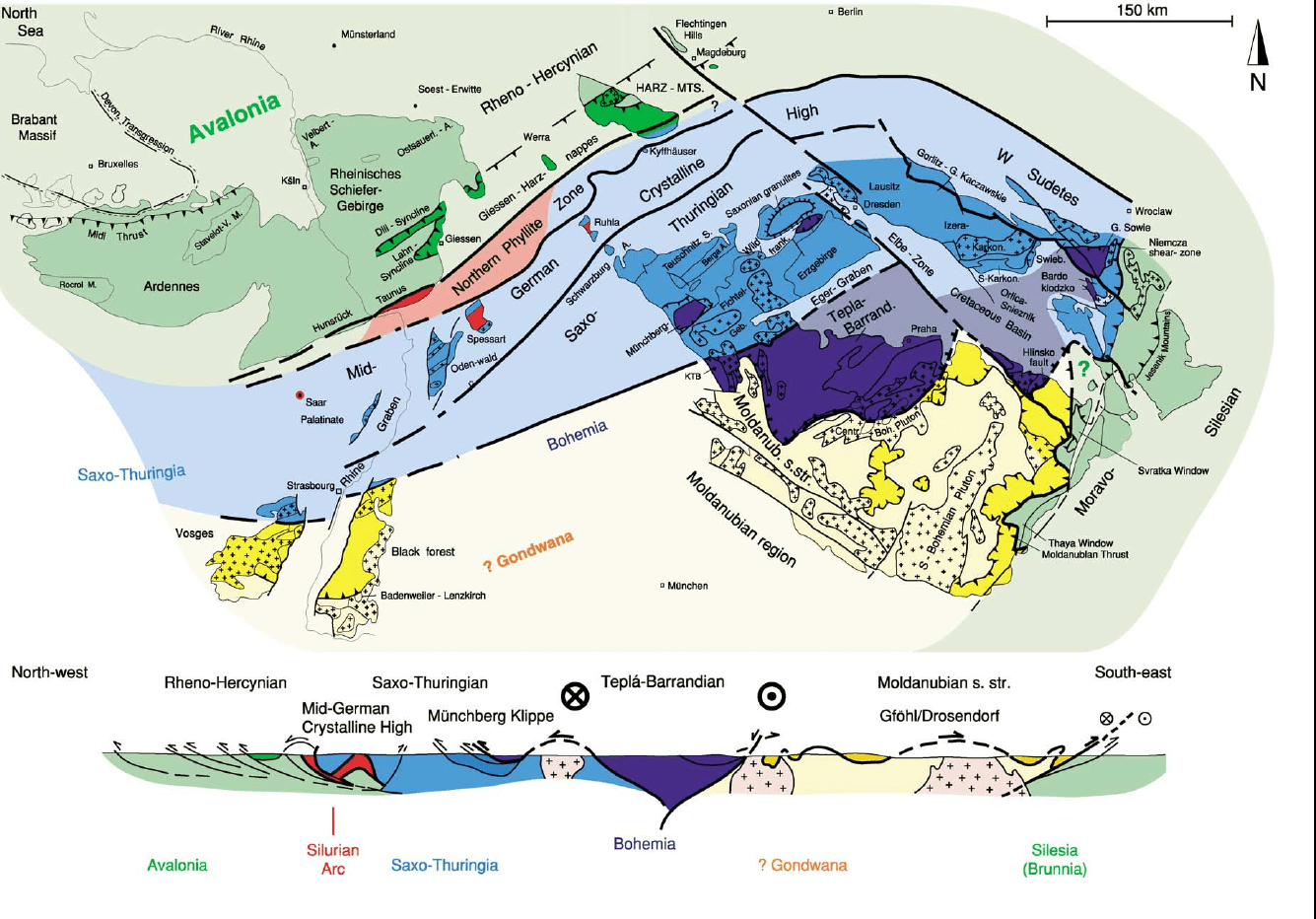
Figure 5 (A) Tectonic and palaeogeographical subdivision of the Variscan basement in central Europe. (B) Simplified tectonic cross section. A, Anticline; KTB, German Continental Deep
Drilling site; M, Massif; S, South (as in S-Bohemian Pluton); Tepla
´
-Barrand, Telpa
´
-Barrandian; Centr. Boh. Pluton, Central Bohemian Pluton; S-karkon, South-Karkonasze.
EUROPE/Variscan Orogeny 81
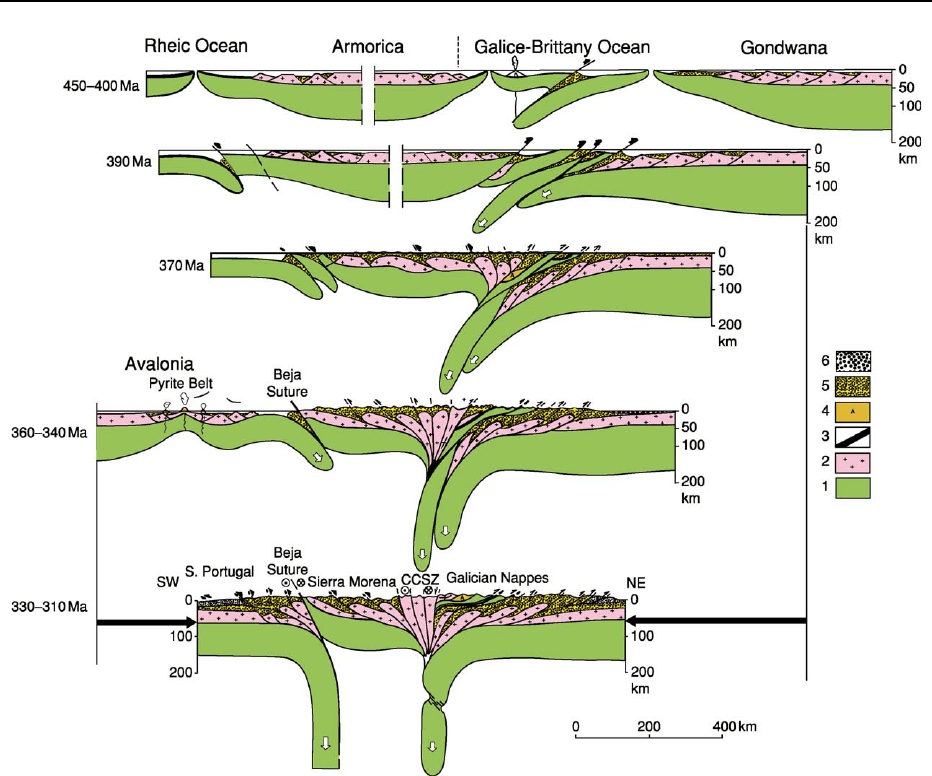
the situation in the central European section, there
appears to be only one Armorican microcontinent
(instead of Saxo-Thuringia and Bohemia). Nappes
and sutures of the Ibero-Armorican domain are
characterized by oceanic lithospheric rocks and
early (420–370 Ma) ultrahigh-pressure, high-pressure
and medium-pressure metamorphism. The most ex-
ternal parts of the belt comprise low-grade to non-
metamorphic Carboniferous marine to paralic basins,
which were deformed between 320 Ma and 290 Ma.
The structures and tectonothermal histories of the
Iberian and French sections of the Variscan Ibero-
Armorican arc are described below (Figures 6 and 7).
The Iberian section (Figures 6 and 7A) combines a
southern segment from the South Portuguese Zone
to the Central Iberian Zone and a northern seg-
ment based upon observations in north-western
Spain (Figure 1). The northern segment originated
from the closure of the Galicia-Brittany–Massif
Central–Moldanubian ocean. Westward-directed sub-
duction (in present-day coordinates) under an Armor-
ican terrane affected first oceanic and then continental
rocks between about 400 Ma and 300 Ma. Collision
produced an eastward-facing accretionary wedge,
in which deformation migrated from west to east.
The lower autochthonous part consists of Early
Palaeozoic shallow-water sediments deposited on
the margin of Gondwana. The upper allochthonous
part includes, from bottom to top, rocks of a passive
margin thinned during the Ordovician, ophiolitic
rocks (400–480 Ma) of arc or oceanic mantle,
representing the remnants of the Galicia-Brittany–
Massif Central ocean, and an uppermost ultra-
nappe, which may represent the extended eastern
margin of Armorica.
The southern segment of the Iberian section shows
an opposite orogenic polarity, with south-west-facing
folds and thrust sheets. Four main units are separated
Figure 6 Plate kinematic evolution of the Variscan belt in Iberia: 1, mantle; 2, continental crust; 3, oceanic crust; 4, volcanic island
arc; 5, Early Palaeozoic sediments; 6, Carboniferous foreland sediments. CCSZ, Coimbra-Cordoba-Shear Zone.
82 EUROPE/Variscan Orogeny
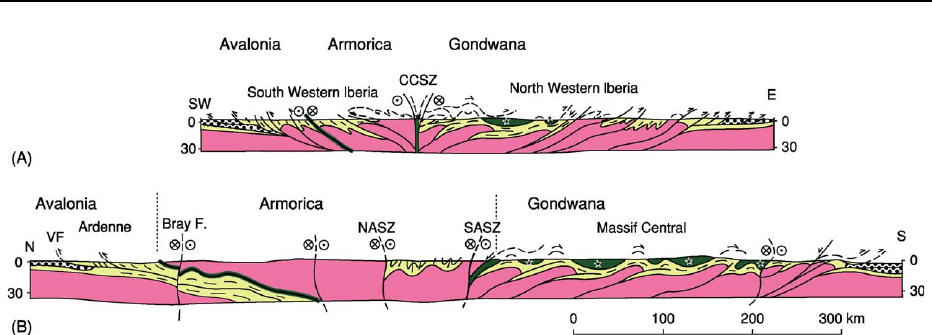
by major faults and/or sutures and are discussed
below.
The Central Iberian Zone is the southern continu-
ation of the autochthonous series of the northern
Iberian section, with Early Palaeozoic rocks uncon-
formably overlying low-grade Proterozoic sediments.
A very important intracontinental sinistral shear
zone separates the Central Iberian Zone from the
Ossa Morena Zone and marks the boundary between
tectonic domains with north-east and south-west ver-
gences. This shear zone either represents or overprints
the suture zone in which the north-west Iberian alloch-
thon is rooted. There is evidence of very peculiar
Ordovician magmatism with alkaline to peralkaline
gneisses.
The Ossa Morena Zone shows a relatively com-
plete fossiliferous Early Palaeozoic record from the
lowermost Cambrian through to the Silurian and
Devonian. Lower Cambrian sandstones and lime-
stones unconformably overlie Upper Proterozoic
rocks that are characterized by the presence of black
cherts metamorphosed and intruded by Cadomian
granitoids (550–500Ma) as in northern Brittany. In
some places (e.g. Cordoba) calc-alkaline andesites
erupted during the latest Proterozoic/Early Cambrian.
The Ossa Morena Zone shows large south-west-facing
recumbent folds emplaced before the Early Carbon-
iferous (which is, in part, coal-bearing). The Variscan
metamorphism (epizonal to catazonal) is of a high-
temperature–low-pressure type, and an important
Variscan magmatism (diorites and granodiorites) is
present. The present-day southern boundary of the
Ossa Morena Zone is considered to be a suture,
based on the existence of a belt of oceanic amphibolites
(Beja-Acebuches) thrust over a possibly Devonian
accretionary prism with slices of oceanic metabasalts.
This north-west–south-east-trending boundary with
the South Portuguese Zone has been reworked as a
sinistral wrench fault.
The South Portuguese Zone exposes only Devonian
and Carboniferous sediments and is characterized
by important bimodal Tournaisian volcanic deposits,
which contain the largest copper ore bodies in West-
ern Europe (the South Portuguese Pyrite Belt). Time-
equivalent volcanic rocks are known from south-west
England and are widespread in the Rheno-Hercynian
Belt of Germany. The Rheno-Hercynian and, hence,
Avalonian affinities of the South Portuguese Zone are
also suggested by a thick turbidite sequence deposited
in a foreland basin (‘Culm’ facies), with a change to-
wards paralic deposits in the south-west. It comprises
the Vise
´
an to Westphalian D. The South Portugese
Zone is characterized by south-west-facing folds
and thrusts. Deformation occurred during the Late
Carboniferous.
The French section (see Figure 1 for location) can be
subdivided into three segments. The Massif Central
segment is the most complete section on the southern
flank of the Variscan belt and is exposed over a dis-
tance of 400 km from the Montagne Noire to the
southern margin of the Paris Basin. The Paris Basin
segment is buried beneath Mesozoic sediments, but
has been sampled in rare drillings and imaged at
depth by a wide-angle reflection profile. Potentially
equivalent rocks are exposed to the west in central
Brittany. The Ardennes section is partly buried be-
neath the sediments of the Paris Basin, but is well
known at depth from drilling, coal mining, and a
Figure 7 Simplified tectonic cross sections through the Variscan belt in (A) the Iberian peninsula and (B) France: pink, pre-
Palaeozoic basement and early Palaeozoic granitoids (undifferentiated); yellow, Early Palaeozoic sediments; green, thrust sheets
with Early Palaeozoic ophiolites; dots, Carboniferous foreland basin deposits; VF, Variscan Front; Bray F, Bray Fault, NASZ, North
Armoricn Shear Zone; SASZ, South Armorican Shear Zone; CCSZ, Coimbra-Cordoba-Shear Zone.
EUROPE/Variscan Orogeny 83

deep seismic-reflection profile. Approximately
100 km of section are well exposed along the Meuse
River in the Ardennes.
In the Massif Central segment, three main tecto-
nostratigraphical units may be distinguished. First,
the Montagne Noire at the southern extremity of the
Massif Central consists of fossiliferous Palaeozoic sedi-
ments including Lower Cambrian shallow-water sand-
stones and limestones, Lower Ordovician shales and
sandstones, Devonian limestones, and a thick turbiditic
syntectonic Visean–Namurian series. The whole of
this lithostratigraphical sequence is involved in large
(10 km) recumbent folds facing south to south-west.
The lowermost para-autochthonous unit (Zone Axiale)
consists of Upper Proterozoic sediments that were
intruded by Ordovician granites at 450–460 Ma. De-
formation and low-pressure metamorphism occurred
between 330 Ma and 310 Ma.
Second, the ‘Schistes des Ce
´
vennes-Albigeois’ are a
very thick (possibly around 4000 m) greenschist-grade
series, probably derived from both Early Palaeozoic
and Late Proterozoic protoliths. They were intruded
by Cambrian–Ordovician diorites and granites at
540–460 Ma. The Ce
´
vennes series shows a northwards
gently dipping slaty cleavage related to a pervasive
southward or south-westward shearing. Barrovian-
type metamorphism increases towards the top of the
pile (inverted). Deformation and metamorphism oc-
curred between 350 Ma and 340 Ma. Large granitic
plutons were emplaced between 330 Ma and 305 Ma.
Third, the complex Leptyno-Amphibolitic Group
consists of mafic and ultramafic rocks characterized
by high-pressure to ultrahigh-pressure metamorphism
(in places they consist of coesite-bearing eclogites). It is
a very large (300 km) nappe with ophiolite fragments.
The probable root zone in the southernmost part of
the Paris Basin is marked by a significant positive
gravity anomaly. The Leptyno-Amphibolitic Group is
overlain by pelitic gneisses with slices of high-pressure
granulites and peridotites. Metamorphism has been
dated at 420 Ma (high-pressure) to 380 Ma (Barro-
vian). All these units are intruded by various types of
Variscan granites, which were emplaced between
360 Ma and 300 Ma.
The Ardennes segment is well documented from
drilling, coal-mining, and surface outcrops in the Ar-
dennes. Like the more easterly Rhenish Massif, this
segment represents the northern flank of the Euro-
pean Variscan Belt. Palaeozoic fossiliferous sediments
with a thick Devonian clastic wedge are involved in a
large north-west-facing fold and thrust belt, which
has been well imaged by ECORS (France) and
DEKORP (Germany) deep reflection profiles. The
main frontal thrust (Faille du Midi), exposed at the
France–Belgium border, carries Devonian rocks over
the Late Carboniferous coal basin. Deformation
occurred at around 300 Ma.
Features Characteristic of the
Variscan Belt
The central parts of the Variscan belt are intruded by
huge volumes of granite. In contrast to the situation
in many other orogenic belts, most of these granites
were not formed over oceanic subduction zones but
originated from the melting of metasediments in
the continental crust. Heating and melting of the
crust probably occurred initially when the crust was
thickened (two mica and cordierite leucogranites) and
then later when subducted parts of the subcontinental
lithospheric mantle became detached and sank back
into the asthenospheric mantle. This permitted the
upward ascent of hot asthenospheric mantle and
advection of heat to the crust.
The Variscan crust is rich in unstable isotopes
(mainly potassium, uranium, and thorium), whose
decay may produce up to 30% of the heat flow ob-
served in continental rocks. These heat-producing
isotopes were extracted from the mantle by repeated
magmatic episodes, shortly before and during Varis-
can plate convergence (Cadomian subduction mag-
matism, Cambro-Ordovician rift magmatism, and
subduction- and collision-related magmatism in the
Devonian and Carboniferous). These elements are
also contained in mica and feldspar, two main con-
stituents of the thick Early Palaeozoic shelf deposits,
which piled up during the collision of the major and
minor plates.
For these reasons, the Variscan orogen was ‘hot’ in
comparison with ‘cold’ orogens such as the Alps (see
Europe: The Alps), the Caledonides (see Europe: Scan-
dinavian Caledonides (with Greenland); Caledonides
of Britain and Ireland), and the Urals (see Europe: The
Urals). The high temperatures prevailing during con-
tinental collision effected mechanical weakening of the
crust. This is documented by the ‘squeezing out’ of
melts or low-viscosity metamorphic rocks towards
the forelands. The same effect is responsible for the
rapid destruction of the orogenic ‘root’. When heated,
the deeper parts of the thickened crust spread laterally
like oil on water. Therefore, the base of the continental
crust (the Mohorovicic discontinuity) had already
levelled out at a depth of about 30–35 km by Late
Carboniferous or Permian times, i.e. shortly after the
termination of crustal thickening (see Moho Discon-
tinuity). This process was aided by the ascent of
mantle-derived melts during the Permian, which initi-
ated the break-up of Pangaea (see Pangaea).
84 EUROPE/Variscan Orogeny

See Also
Europe: Caledonides of Britain and Ireland; Scandi-
navian Caledonides (with Greenland); The Urals; The
Alps. Moho Discontinuity. Palaeomagnetism. Palaeo-
zoic: Ordovician. Pangaea. Tectonics: Convergent Plate
Boundaries and Accretionary Wedges; Mountain Building
and Orogeny.
Further Reading
Burg JP, Leyreloup A, Marchand J, and Matte P (1984)
Inverted metamorphic zonation and large scale
thrusting in the Variscan Belt: an example in the
French Massif Central. In: Hutton DHM and Sanderson
PJ (eds.) Variscan Tectonics of the North Atlantic Region.
pp. 47–61. Special Publication 14. London: Geological
Society.
Fortey RA and Cocks LRM (2003) Palaeontological evi-
dence bearing on global Ordovician–Silurian continental
reconstructions. Earth Science Reviews 61: 245–307.
Franke W (2000) The mid-European segment of the Varis-
cides: tectonostratigraphic units, terrane boundaries and
plate tectonic evolution. In: Franke W, Haak V, Oncken
O, and Tanner D (eds.) Orogenic Processes: Quantifica-
tion and Modelling in the Variscan Belt, pp. 35–62.
Special Publication 179. London: Geological Society.
Franke W and Stein E (2000) Exhumation of high-
grade rocks in the Saxo-Thuringian Belt: geological con-
straints and geodynamic concepts. In: Franke W, Haak V,
Oncken O, and Tanner D (eds.) Orogenic Processes:
Quantification and Modelling in the Variscan Belt, pp.
337–354. Special Publication 179. London: Geological
Society.
Franke W and Zelazniewicz A (2002) Structure and evolu-
tion of the Bohemian Arc. In: Winchester JA, Pharaoh
TC, and Verniers J (eds.) Palaeozoic Amalgamation of
Central Europe, pp. 279–293. Special Publication 201.
London: Geological Society.
Kossmat F (1927) Gliederung des varistischen Gebirgs-
baues. Abhandlungen des Sa¨chsischen Geologischen
Landesamtes, Neue Folge 1: 1–39.
McKerrow WS, MacNiocaill C, Ahlberg PE, et al. (2000)
The late Palaeozoic relations between Gondwana and
Laurussia. In: Franke W, Haak V, Oncken O, and
Tanner D (eds.) Orogenic Processes: Quantification and
Modelling in the Variscan Belt, pp. 9–20. Special Publi-
cation 179. London: Geological Society.
Martinez-Catalan JR, Arenas R, Diaz Garcia F, and Abati J
(1997) Variscan accretionary complex of northwestern
Iberia: terrane correlation and succession of tectonother-
mal events. Geology 25: 1103–1106.
Matte P (1998) Continental subduction and exhumation of
HP rocks in Paleozoic belts: Uralides and Variscides.
Journal of the Geological Society of Sweden 120:
209–222.
Matte P (2001) The Variscan collage and orogeny (480–290
Ma) and the tectonic definition of the Armorica micro-
plate: a review. Terra Nova 13: 122–128.
Owen AW, Harper DAT, and Rong Jia-Yu (1991) Hirnan-
tian trilobites and brachiopods in space and time. In:
Barnes CR and Williams SH (eds.) Ordovician Geology,
pp. 179–190. Ontario, Canada: Geological Survey of
Canada.
Robardet M, Verniers J, Feist R, and Paris F (1994) Le
Pale
´
ozoique ante
´
-varisque de la France, contexte pale
´
o-
ge
´
ographique et ge
´
odynamique. Ge
´
ologie de la France 3:
3–31.
Scho
¨
nlaub HP (1992) Stratigraphy, biogeography and
paleoclimatology of the Alpine Paleozoic and its implica-
tions for plate movements. Jahrbuch der Geologischen
Bundesanstalt 135: 381–418.
Scotese CR, Boucot AJ, and McKerrow WS (1999) Gond-
wanan palaeogeography and palaeoclimatology. Journal
of African Earth Sciences 28: 99–114.
Simancas JF, Carbonell R, Gonzalez Lodeiro F, et al. (2003)
The crustal structure of the transpressional Variscan oro-
gen of SW Iberia: the IBERSEIS deep seismic reflection
profile. Tectonics 22. DOI 10.1029/2002TC001479.
Stampfli GM (1996) The intra-alpine terrain: a Paleoteth-
yan remnant in the Alpine Variscides. Eclogae Geologi-
cae Helvetiae 89: 13–42.
Suess E (1888) Das Antlitz der Erde, vol. IV. Prague, F.
Tempsky.
Tait J, Scha
¨
tz M, Bachtadse V, and Soffel H (2000) Palaeo-
magnetism and Palaeozoic palaeogeography of Gon-
dwana and European terranes. In: Franke W, Haak V,
Oncken O, and Tanner D (eds.) Orogenic Processes:
Quantification and Modelling in the Variscan Belt, pp.
21–34. Special Publication 179. London: Geological
Society.
Torsvik TH, Smethurst MA, Meert JG, et al. (1996) Con-
tinental break-up and collision in the Neoproterozoic and
Palaeozoic: a tale of Baltica and Laurentia. Earth Science
Reviews 40: 229–258.
Van der Voo R (1993) Paleomagnetism of the Atlantic,
Tethys and Iapetus Oceans. Cambridge: Cambridge
University Press.
Wegener A (1915) Die Entstehung der Kontinente und
Ozeane. Braunschweig: Vieweg.
EUROPE/Variscan Orogeny 85

The Urals
D Brown, Instituto de Ciencias de la Tierra ‘Jaume
Almera’, CSIC, Barcelona, Spain
H Echtler, GeoForschungsZentrum Potsdam,
Potsdam, Germany
ß 2005, Elsevier Ltd. All Rights Reserved.
Introduction
The Uralide Orogen was one of the main mountain
belts built during the Palaeozoic assembly of the
supercontinent Pangaea. Since the breakup of Pan-
gaea in the Mesozoic, the Uralides have remained
intact and are today located in the interior of the
Eurasia Plate. The current extent of the orogen is
seen by its roughly north- and south-oriented mag-
netic signature, which abruptly interrupts that of
Baltica, Kazakhstan, and Siberia, the tectonic plates
that collided to form the Uralides (Figure 1A). Most
of what is known about the Uralide orogen is con-
fined to the present-day Ural Mountains, a narrow
range of low to moderate topography extending for
nearly 2500 km from near the Aral Sea in the south
to the islands of Novaya Zemlya in the Arctic Ocean
(Figure 1B). East and south of the Ural Mountains,
much of the orogen is buried beneath Mesozoic and
Cenozoic sediments of the West Siberian and Precas-
pian basins and is not well known. For descriptive
purposes, the geology of the Uralide Orogen has been
divided into a number of longitudinal zones that are
largely based on the ages and palaeogeography of the
dominant rocks within them. From west to east, these
zones are the Pre-Uralian zone, the West Uralian
zone, the Central Uralian zone, the Magnitogorsk–
Tagil zone, the East Uralian zone, and the Trans-
Uralian zone (Figure 1C). Additionally, the Uralides
have been divided geographically into the South,
Middle, North, Cis-Polar, and Polar Urals; the
following discussions focus on the South and Middle
Urals (Figure 2).
The Pre-Uralian, West Uralian, and Central Uralian
zones, which together make up the western foreland
thrust-and-fold belt, contain Late Carboniferous
to Early Triassic sediments of the foreland basin,
Palaeozoic platform and slope sediments of the
Baltica margin, and Archaean and Proterozoic rocks
of the East European Craton (that part of the cra-
tonic nucleus of Baltica that took part in the Uralide
orogeny) (see Europe: East European Craton).
The Magnitogorsk–Tagil zone is made up of two
volcanic arcs, the Magnitogorsk Arc (South Urals),
which is composed of Lower Devonian to Middle
Devonian basalts that are overlain by Upper
Devonian volcanoclastic sediments, and the Tagil
Arc (Middle Urals), which is composed of Silurian
to Lower Devonian basalts and volcanoclastic sedi-
ments that are locally overlain by Lower and Middle
Devonian sediments. The East Uralian zone is com-
posed predominantly of deformed and metamorph-
osed volcanic arc fragments with minor amounts
of Precambrian and Palaeozoic rocks thought to
represent continental crust. The East Uralian zone
was extensively intruded by Carboniferous and
Permian granitoids, forming the ‘main granite axis’
of the Uralides. The Trans-Uralian zone is composed
of Devonian and Carboniferous volcanic and plu-
tonic complexes overlain by terrigenous redbeds and
evaporites. Ophiolitic material (oceanic crust) and
high-pressure rocks have also been reported.
Tectonic Evolution
The tectonic evolution of the Uralides (Figure 3)
began during the Devonian as intra-oceanic subduc-
tion formed the Magnitogorsk and Tagil island arcs
(island arcs form along convergent margins when one
oceanic plate subducts beneath another oceanic
plate). This was followed by the entry of the contin-
ental margin of Baltica into the subduction zone and
the emplacement of an accretionary complex over the
continental margin, and the exhumation of high-
pressure rocks (the process of bringing the rocks in
question from depth toward the surface) along the
arc–continent collision boundary. At the same time,
subcontinental subduction (in which oceanic crust
subducts beneath continental crust) and volcanic arc
formation appear to have been taking place along
the margin of Kazakhstan, and to have continued
throughout the Carboniferous. Throughout much of
the Carboniferous, there was a deformation hiatus
along the Baltica margin, which by then included
the accreted volcanic arcs, and shallow-water plat-
form margin sedimentation continued undisturbed.
By the latest Carboniferous to Early Permian, the
Uralian ocean basin had closed completely and the
continent–continent collision between the Kazakh-
stan and Baltica plates had begun. As this collision
progressed through the Early Permian to the Early
Triassic, the western foreland thrust-and-fold belt
and foreland basin of the Uralides developed, while
widespread strike–slip faulting, with exhumation of
lower crustal material accompanied by melt gener-
ation and granitoid emplacement, took place in the
interior part of the orogen. An episode of Early Trias-
sic extension and volcanism followed in the eastern
86 EUROPE/The Urals

Figure 1 (A) Total field aeromagnetic map. The north-east-trending short-wavelength anomalies represent the Uralides. Courtesy of National Geophysical Data Center. (B) Topography of
the Ural Mountains. Note that the topography corresponds only to the western part of the orogen. Courtesy of National Geophysical Data Center. (C) Map of the Uralide Orogen outlining the
extent of the different zones and geographical areas discussed in the text.
EUROPE/The Urals 87
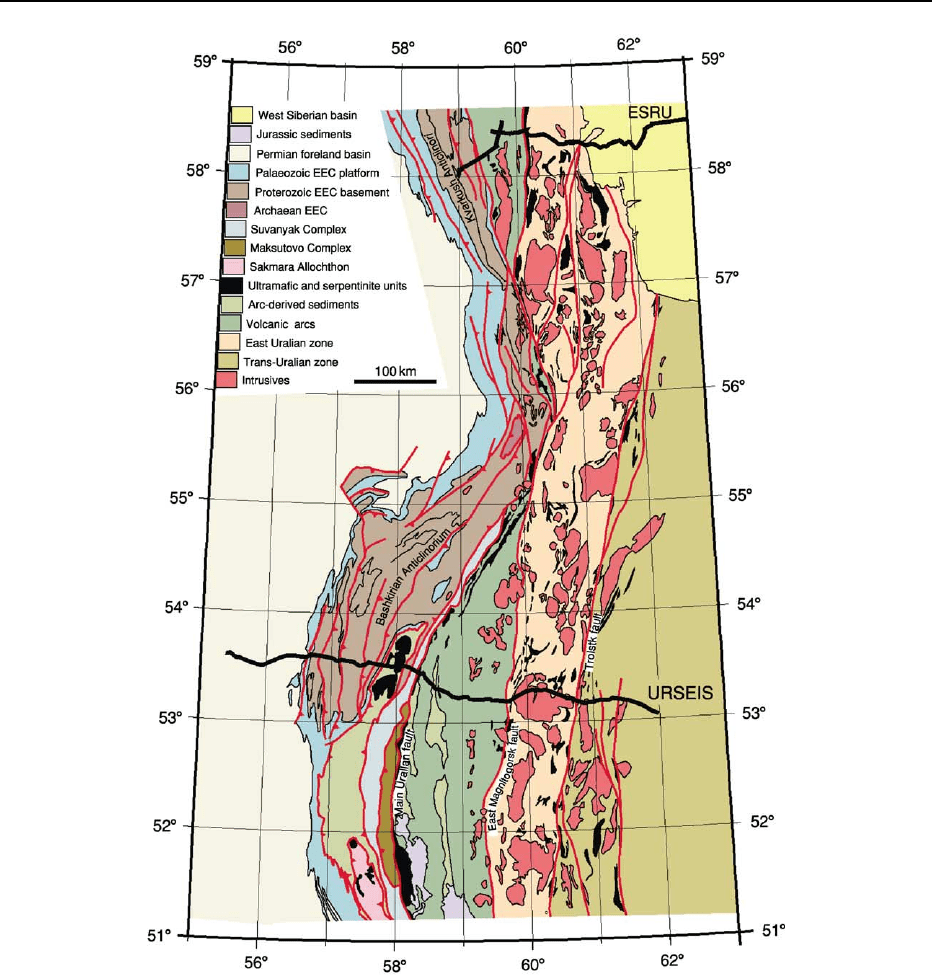
part of the Middle Urals and northward; by the
mid-Jurassic, the intraplate Old Cimmerian deforma-
tion event led to the uplift of the Timan Range and
formation of the Pay–Khoy–Novozemelian foldbelt in
the northernmost Uralides (Figure 1C), and localized
the deformation southward.
Arc–Continent Collision
Throughout geological time, intra-oceanic island arc
development and its subsequent collision with a con-
tinental margin have been important processes in
collisional orogenic belts, and among the most im-
portant means by which Earth’s continental crust has
grown. In the case of the Uralides, the Tagil and
Magnitogorsk island arcs developed from the Silurian
(Tagil) and Early Devonian (Magnitogorsk) and
began to collide with the margin of Baltica in the
Middle Devonian (Magnitogorsk) and the Early
Carboniferous (Tagil) (Figure 3 shows this evolution
schematically for the Magnitogorsk Arc). The Tagil
Arc was pervasively deformed and metamorphosed
to lower greenschist facies. Deformation in the
Figure 2 Geological map of the South and Middle Urals. The location of the Europrobe Seismic Reflection profiling in the Urals
(ESRU) and Urals Seismic Experiment and Integrated Studies (URSEIS) transects are shown.
88 EUROPE/The Urals

Magnitogorsk arc is low, with only minor, open fol-
ding and minor thrusting. The metamorphic grade is
prenhite–pumpellyite facies. The Magnitogorsk arc–
continent collision resulted in the development of
an accretionary complex (Figure 3) that involved
continental slope and platform sedimentary rocks
(Suvanyak Complex) (Figure 2) that were detached
from the margin of Baltica and thrust westward over
the continental margin. The Suvanyak Complex is
overthrust by syncollisional volcanoclastic sediments
sourced from the accretionary complex and the Mag-
nitogorsk arc (Zilair Formation). These units are
flanked to the east by the high-pressure eclogite- and
blueschist-bearing gneisses of the Maksutovo Com-
plex (Figure 2), which records a peak metamorphic
pressure of 20 4 kbar (0.3 kbar is roughly equiva-
lent to burial 1 km deep in Earth’s crust) and tempera-
ture of 550 50
C, and a peak metamorphic age of
380 to 370 Ma (during the Middle Devonian). The
highest structural level of the accretionary complex is
the Sakmara Allochthon in the south (Figure 2)and
the Kraka lherzolite massif (a piece of oceanic mantle)
in the north. The east-dipping Main Uralian fault,
along which the arcs are sutured to the continental
margin, is a fault melange that contains, among other
things, several kilometre-scale fragments of oceanic
crust and mantle.
Subcontinental Subduction
Little is known about what happened on the margin
of the Kazakhstan Plate prior to or during its collision
with Baltica, because no rocks that can be unequivo-
cally assigned to the plate have been recognized in the
Uralides. However, studies suggest subcontinental
subduction and the development of a continental vol-
canic arc did occur. In part, the evidence for this
comes from Silurian- to Devonian-age mafic to felsic
gneisses and volcano-sedimentary rocks in the East
Uralian zone that appear to represent a volcanic arc
complex. The key piece of data for assigning these
Figure 3 A simplified model for the tectonic evolution of the Uralides from the Early Devonian to the Early Triassic along the latitude
of the Magnitogorsk Arc, highlighting the geodynamic processes that were active at each stage.
EUROPE/The Urals 89
